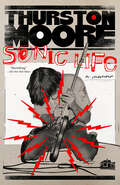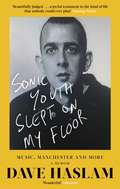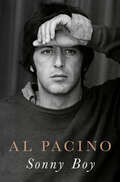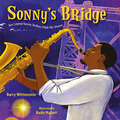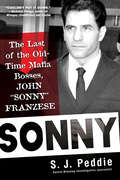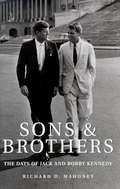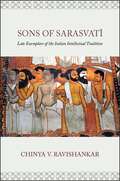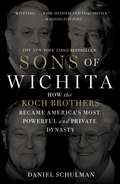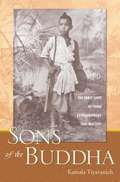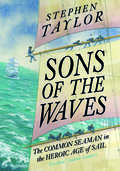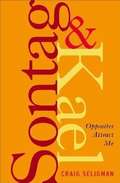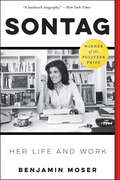- Table View
- List View
Sonic Boom: The Impossible Rise of Warner Bros. Records, from Hendrix to Fleetwood Mac to Madonna to Prince
by Peter Ames CarlinFrom journalist Peter Ames Carlin—the New York Times bestselling music biographer who chronicled the lives and careers of Paul McCartney, Bruce Springsteen, the Beach Boys, and Paul Simon—Sonic Boom captures the rollicking story of the most successful record label in the history of rock and roll, Warner Bros Records, and the remarkable secret to its meteoric rise.The roster of Warner Brothers Records and its subsidiary labels reads like the roster of the Rock & Roll Hall of Fame: Jimi Hendrix, the Grateful Dead, Joni Mitchell, Neil Young, James Taylor, Fleetwood Mac, the Eagles, Prince, Van Halen, Madonna, Tom Petty, R.E.M., Red Hot Chili Peppers, and dozens of others. But the most compelling figures in the Warner Bros. story are the sagacious Mo Ostin and the unlikely crew of hippies, eccentrics, and enlightened execs who were the first in the music business to read the generational writing on the wall in the mid-1960s. By recruiting outsider artists and allowing them to make the music they wanted, Ostin and his staff transformed an out-of-touch company into the voice of a generation. Along the way, they revolutionized the music industry and, within just a few years, created the most successful record label in the history of the American music industry.How did they do it? It all goes back to the day in 1967 when the newly tapped label president Mo Ostin called his team together to share his grand strategy for the struggling company: “We need to stop trying to make hit records. Let’s just make good records and turn those into hits.”With that, Ostin ushered in a counterintuitive model that matched the counterculture. His offbeat crew reinvented the way business was done, giving their artists free rein while rejecting out-of-date methods of advertising, promotion, and distribution. And even as they set new standards for in-house weirdness, the upstarts’ experiments and innovations paid off, to the tune of hundreds of legendary hit albums.It may sound like a fairy tale, but once upon a time Warner Bros Records conquered the music business by focusing on the music rather than the business. Their story is as raucous as it is inspiring, pure entertainment that also maps a route to that holy grail: love and money.Includes black-and-white photographs
Sonic Life: A Memoir
by Thurston MooreFrom the founding member of Sonic Youth, a passionate memoir tracing the author's life and art—from his teen years as a music obsessive in small-town Connecticut, to the formation of his legendary rock group, to thirty years of creation, experimentation, and wonder"Downtown scientists rejoice! For Thurston Moore has unearthed the missing links, the sacred texts, the forgotten stories, and the secret maps of the lost golden age. This is history—scuffed, slightly bent, plenty noisy, and indispensable." —Colson Whitehead, Pulitzer Prize–winning author of The Underground Railroad and Harlem Shuffle Thurston Moore moved to Manhattan&’s East Village in 1978 with a yearning for music. He wanted to be immersed in downtown New York&’s sights and sounds—the feral energy of its nightclubs, the angular roar of its bands, the magnetic personalities within its orbit. But more than anything, he wanted to make music—to create indelible sounds that would move, provoke, and inspire.His dream came to life in 1981 with the formation of Sonic Youth, a band Moore cofounded with Kim Gordon and Lee Ranaldo. Sonic Youth became a fixture in New York&’s burgeoning No Wave scene—an avant-garde collision of art and sound, poetry and punk. The band would evolve from critical darlings to commercial heavyweights, headlining festivals around the globe while helping introduce listeners to such artists as Nirvana, Hole, and Pavement, and playing alongside such icons as Neil Young and Iggy Pop. Through it all, Moore maintained an unwavering love of music: the new, the unheralded, the challenging, the irresistible.In the spirit of Just Kids, Sonic Life offers a window into the trajectory of a celebrated artist and a tribute to an era of explosive creativity. It presents a firsthand account of New York in a defining cultural moment, a history of alternative rock as it was birthed and came to dominate airwaves, and a love letter to music, whatever the form. This is a story for anyone who has ever felt touched by sound—who knows the way the right song at the right moment can change the course of a life.
Sonic Skills: Listening For Knowledge In Science, Medicine And Engineering, 1920s-present
by Karin BijsterveldIt is common for us today to associate the practice of science primarily with the act of seeing—with staring at computer screens, analyzing graphs, and presenting images. We may notice that physicians use stethoscopes to listen for disease, that biologists tune into sound recordings to understand birds, or that engineers have created Geiger tellers warning us for radiation through sound. But in the sciences overall, we think, seeing is believing. This open access book explains why, indeed, listening for knowledge plays an ambiguous, if fascinating, role in the sciences. For what purposes have scientists, engineers and physicians listened to the objects of their interest? How did they listen exactly? And why has listening often been contested as a legitimate form of access to scientific knowledge? This concise monograph combines historical and ethnographic evidence about the practices of listening on shop floors, in laboratories, field stations, hospitals, and conference halls, between the 1920s and today. It shows how scientists have used sonic skills—skills required for making, recording, storing, retrieving, and listening to sound—in ensembles: sets of instruments and techniques for particular situations of knowledge making. Yet rather than pleading for the emancipation of hearing at the expense of seeing, this essay investigates when, how, and under which conditions the ear has contributed to science dynamics, either in tandem with or without the eye.
Sonic Wind: The Story of John Paul Stapp and How a Renegade Doctor Became the Fastest Man on Earth
by Craig RyanThe untold story of an eccentric, scientific visionary whose death-defying research has saved millions of lives. Sixty years ago, cars and airplanes were still deathtraps waiting to happen. Today, both are safer than ever, thanks in part to one pioneering air force doctor's research on seatbelts and ejection seats. The exploits of John Paul Stapp (1910-1999) come to thrilling life in this biography of a Renaissance man who was once blasted--faster than a .45 caliber bullet--across the desert in his Sonic Wind rocket sled, only to be slammed to a stop in barely a second. The experiment put him on the cover of Time magazine and allowed his swashbuckling team to gather the data needed to revolutionize automobile and aircraft design. But Stapp didn't stop there. From the legendary high-altitude balloon tests that ensued to the ferocious battles for car safety legislation, Craig Ryan's book is as much a history of America's transition into the Jet Age as it is a biography of the man who got us there safely.
Sonic Youth Slept On My Floor: Music, Manchester, and More: A Memoir
by Dave Haslam'Beautifully judged account of the Manchester scene . . . There is something of the fairy tale about Dave Haslam's sage joyful testament to the kind of life that nobody could ever plan, a happy aligning of a cultural moment and a young man who instinctively knew that it was his once upon a time' Victoria Segal, Sunday Times'Witty, sometimes dark, revealing, insightful, everything one could hope for from one of those folk without whom independent music simply wouldn't exist' Classic RockSonic Youth Slept on My Floor is writer and DJ Dave Haslam's wonderfully evocative memoir. It is a masterful insider account of the Hacienda, the rise of Madchester and birth of the rave era, and how music has sound-tracked a life and a generation.In the late 1970s Dave Haslam was a teenage John Peel listener and Joy Division fan, his face pressed against a 'window', looking in at a world of music, books and ideas. Four decades later, he finds himself in the middle of that world, collaborating with New Order on a series of five shows in Manchester. Into the story of those intervening decades, Haslam weaves a definitive portrait of Manchester as a music city and the impact of a number of life-changing events, such as the nightmare of the Yorkshire Ripper to the shock of the Manchester Arena terror attack.The cast of Haslam's life reads like a who's who of '70s, '80s and '90s popular culture: Tony Wilson, Nile Rodgers, Terry Hall, Neneh Cherry, Tracey Thorn, John Lydon, Johnny Marr, Ian Brown, Laurent Garnier and David Byrne. From having Morrissey to tea and meeting writers such as Raymond Carver and Jonathan Franzen to discussing masturbation with Viv Albertine and ecstasy with Roisin Murphy, via having a gun pulled on him at the Hacienda and a drug dealer threatening to slit his throat, this is not your usual memoir.
Sonita: My Fight Against Tyranny and My Escape to Freedom
by Sonita AlizadaNearly 15 million girls, including many in the U.S., are forced into marriage each year. Each of these girls has a price tag—and a story. Sonita Alizada was almost sold twice. Her price tag was $9,000. The money her family received for selling her would pay for her brother’s wife. The first time Sonita was put up for sale, she was 10 years old and she thought that she was participating in a dress-up game. She quickly realized that, in her culture, a wedding is a kind of funeral for the bride. Sonita says, “It represents the loss of a future. The loss of a voice.” After the marriage fell through, she was placed on sale again. She was expected to form a family, sleep with a man she never met, and then repeat the terrible cycle with her own children. But Sonita wanted more.In Sonita, the Afghan rap artist and activist shares the story of how she fled Afghanistan to pursue her dreams and evolved into a woman who is changing the world. She shares incredible highs, like winning the song writing contest that gave her the opportunity of a lifetime, and unimaginable lows, like when the cruel Taliban regained control of Afghanistan, and how some of her family escaped, and how some were left behind. Sonita also shares photos and access to exclusive music.Sonita teaches us to hold onto hope. You were chosen to be part of this world and your dreams have power, too. You can be a difference maker. This book is more than Sonita's story. It is a love letter for anyone who has ever dreamed of more and held onto hope that their story would be different than the ones that came before them.
Sonny Bill Williams: You Can't Stop the Sun from Shining
by Alan Duff Sonny Bill WilliamsSonny Bill Williams (SBW) is a once in a hundred-year athlete with immense sporting talent in Rugby League, Rugby Union and Boxing. Sonny Bill has built an incredible career and sporting reputation across the globe. His athleticism has taken him from inner-city Auckland, where he grew up, to the highest sporting moments in Twickenham, Eden Park and Sydney's Olympic Stadium. But there is so much more to Sonny Bill Williams' life and journey than his on-field and in-the-ring triumphs. Sonny Bill's love of family, his faith, his skill and performance throughout his unparalleled sporting career, his ability to unite a team under pressure, his grace in owning his mistakes, the challenges of leaving home as a young man and dealing with a negative culture and the temptations that followed, and his courage in speaking out for the vulnerable and calling out injustice are all aspects of an inspiring life story.Sonny Bill Williams was the first Muslim to play for the All Blacks. Driven by a fierce moral compass, Sonny Bill Williams thoughtfully and authentically uses his standing and platform as both a UNICEF Ambassador and an elite sportsperson to speak out on political issues that confront the world today and to benefit those struggling in life. He is a dedicated family man, devoted to his faith, committed to his teammates, respectful of his fans and aware that the path he has taken can inspire and empower others. Working with Alan Duff, award-winning author of Once Were Warriors, this will be the must-read autobiography of the year.
Sonny Boy: A Memoir
by Null Al PacinoThe Instant New York Times Bestseller. “The book is a beautiful trip.” (New York Times Magazine) “Soulful . . . Feels like hanging out within a history of American movies over the last 50 years.” (Los Angeles Times) “Startlingly cinematic ... A fine memoir.” (The Guardian) From one of the most iconic actors in the history of film, an astonishingly revelatory account of a creative life in full To the wider world, Al Pacino exploded onto the scene like a supernova. He landed his first leading role, in The Panic in Needle Park, in 1971, and by 1975, he had starred in four movies—The Godfather and The Godfather Part II, Serpico, and Dog Day Afternoon—that were not just successes but landmarks in the history of film. Those performances became legendary and changed his life forever. Not since Marlon Brando and James Dean in the late 1950s had an actor landed in the culture with such force. But Pacino was in his mid-thirties by then, and had already lived several lives. A fixture of avant-garde theater in New York, he had led a bohemian existence, working odd jobs to support his craft. He was raised by a fiercely loving but mentally unwell mother and her parents after his father left them when he was young, but in a real sense he was raised by the streets of the South Bronx, and by the troop of buccaneering young friends he ran with, whose spirits never left him. After a teacher recognized his acting promise and pushed him toward New York’s fabled High School of Performing Arts, the die was cast. In good times and bad, in poverty and in wealth and in poverty again, through pain and joy, acting was his lifeline, its community his tribe. Sonny Boy is the memoir of a man who has nothing left to fear and nothing left to hide. All the great roles, the essential collaborations, and the important relationships are given their full due, as is the vexed marriage between creativity and commerce at the highest levels. The book’s golden thread, however, is the spirit of love and purpose. Love can fail you, and you can be defeated in your ambitions—the same lights that shine bright can also dim. But Al Pacino was lucky enough to fall deeply in love with a craft before he had the foggiest idea of any of its earthly rewards, and he never fell out of love. That has made all the difference. <br><b>New York Times Bestseller</b></br>
Sonny Rollins Plays the Bridge
by Gary GolioJames Ransome's glorious art celebrates jazz icon Sonny Rollins and how he found an inspired spot to practice his saxophone when his neighbors complained.Sonny Rollins loved his saxophone. As a teenager, he was already playing with jazz stars and making a name for himself. But in 1959, at age twenty-nine, he took a break from performing—to work on being a better, not just famous, musician. Practicing in a city apartment didn&’t please the neighbors, so Sonny found a surprising alternative—the Williamsburg Bridge. There, with his head in the clouds and foghorns for company, Sonny could play to his heart&’s content and perfect his craft. It was a bold choice, for a bold young man and musician.Sonny&’s passion for music comes alive in jazzy text and vivid, evocative paintings of New York City. His story celebrates striving to be your very best self, an inspiration to music lovers young and old.
Sonny's Bridge: Jazz Legend Sonny Rollins Finds His Groove
by Barry WittensteinThis groovy, bebopping picture book biography chronicles the legendary jazz saxophonist Sonny Rollins's search for inspiration on the Williamsburg Bridge after quitting the jazz scene in 1959.Rollins is one of the most prolific sax players in the history of jazz, but, in 1959, at the height of his career, he vanished from the jazz scene. His return to music was an interesting journey--with a long detour on the Williamsburg Bridge. Too loud to practice in his apartment, Rollins played on the New York City landmark for two years among the cacophony of traffic and the stares of bystanders, leading to the release of his album, The Bridge.Written in rhythmic prose with a bebop edge, this picture-book biography of Sonny Rollins's journey to get his groove back will delight young and old fans alike.
Sonny: The Last of the Old Time Mafia Bosses, John "Sonny" Franzese
by S. J. PeddieAward-winning investigative journalist S. J. Peddie writes the first groundbreaking account of the legendary mafia boss, Sonny Franzese, the head of the Colombo crime family and the financier of the infamous pornographic film Deep Throat. &“Sonny Franzese was a standup guy. He lived his life, and he didn't hurt innocent people. And I knew him my whole life.&” —Former Philadelphia crime boss Ralph Natale. John &“Sonny&” Franzese reportedly committed his first murder at the age of fourteen. A &“made man&” for the Colombo crime family, he operated out of his Long Island home, specializing in racketeering, fraud, loansharking, and other illicit deeds he would deny to his dying day. His career in organized crime spanned over eight decades—and he was sentenced to fifty years in prison for robbery charges. But even behind bars, Sonny Franzese never stopped doing business . . . Through it all, Franzese refused to break the Mafia&’s code of silence. Authorities believe he may have murdered, or ordered the murders of, forty to fifty people. Yet he earned a grudging respect from law enforcement and an absolute reverence from his fellow gangsters. Eventually he managed to outlive them all—until his death in 2020 of natural causes, a rare event in the Mafia. Thanks to a series of exclusive firsthand interviews, the astonishing life story of John &“Sonny&” Franzese can be told in all its bold, brutal, and blood-spattered glory. This is a must-read for anyone fascinated with Mafia history—and a rare look inside a criminal mind that has become the stuff of legend.&“By turns blood-curdling and hilarious, Sonny regales us with the life and career of one of the most powerful and least-known New York Mafia crime bosses. A scrupulously documented and compulsive read.&” —Teresa Carpenter, Pulitzer Prize–winner and author of Mob Girl: A Woman's Life in the Underworld
Sonora: A Novel
by Jenni L Walsh&“Sonora&’s story is about not giving up in the face of setbacks. An inspirational tale.&” —Booklist"This one's for the horse girls, the girls who fell in love with Wild Hearts Can't Be Broken and hoped someday they'd be like the fearless, determined, strong Sonora Carver whose love and belief in her horses made her an icon." --Joy Callaway, international bestselling authorInspired by a true story of one of the first female horse divers, Sonora explores a world of daring feats and extraordinary adventures set in the heyday of the American carnival scene.Sonora Webster is penniless but plucky, and despite the looming Great Depression, she follows her wanderlust, answering an advert to dive with horses. Little does she know that she is about to be thrust into a world teeming with danger, excitement, and fierce competition.As Sonora delves into the cutthroat world of show business, complete with trapeze aerial acts and juggling bears, her undeniable talent and unwavering dedication propel her into the limelight, making her a sensation, and after marrying the show runner, her entire life becomes their act and their horses. But she soon learns that a diver--and her horse--are only as good as their last show, a show some are hellbent on shutting down. When a tragic accident changes her life forever, can Sonora muster the courage to climb the forty-five-foot tower and dive again, risking her life to save the show and their horses from falling into the wrong hands?In Sonora, Jenni L. Walsh vividly captures the spirit of a brave woman who defied societal norms to follow her dreams, diving into the unknown with courage and resilience.
Sons and Brothers: The Days of Jack and Bobby Kennedy
by Richard D. MahoneyMahoney, former JFK Scholar at the U. of Massachusetts and the Kennedy Library and current teacher at the Thunderbird School of International Management in Phoenix, provides a dual biography of Jack and Bobby Kennedy, describing their relationship and the role their bond played in their accomplishments, blunders and, ultimately, their murders. Annotation c. Book News, Inc., Portland, OR (booknews.com)
Sons of Camelot
by Laurence LeamerOne of Bobby Kennedy's first acts after JFK's assassination was to write a letter to his eldest son, reminding him of the obligations of his name. Bobby sent the letter to eleven-year-old Joe, but the message was meant for all his sons and nephews.Sons of Camelot is the compelling story of that message and how it shaped each Kennedy son and grandson in the aftermath of President John F. Kennedy's death. Based on five years of rigorous research and unprecedented cooperation from both the Kennedys and the Shrivers, Sons of Camelot examines the lives characterized by overwhelming drama -- from the most spectacular mishaps, excesses, and tragediesto the remarkable accomplishments that have led to better lives for Americans and others around the world.The third volume in Laurence Leamer's bestselling history of America's first family, Sons of Camelot chronicles the spellbinding journey of a message sent from a father to his son ... from a president to his people.
Sons of Camelot: The Fate of an American Dynasty
by Laurence LeamerOne of Bobby Kennedy's first acts after JFK's assassination was to write a letter to his eldest son, reminding him of the obligations of his name. Bobby sent the letter to eleven-year-old Joe, but the message was meant for all his sons and nephews. Sons of Camelot is the compelling story of that message and how it shaped each Kennedy son and grandson in the aftermath of President John F. Kennedy's death. Based on five years of rigorous research and unprecedented cooperation from both the Kennedys and the Shrivers, Sons of Camelot examines the lives characterized by overwhelming drama -- from the most spectacular mishaps, excesses, and tragedies to the remarkable accomplishments that have led to better lives for Americans and others around the world. The third volume in Laurence Leamer's bestselling history of America's first family, Sons of Camelot chronicles the spellbinding journey of a message sent from a father to his son ... from a president to his people.
Sons of Chinatown: A Memoir Rooted in China and America
by William Gee WongWilliam Gee Wong was born in Oakland, California’s Chinatown in 1941, the only son of his father, known as Pop. Pop was born in Guangdong Province, China and emigrated to Oakland as a teenager during the Chinese Exclusion era in 1912. He entered the U.S. legally as the “son of a native,” despite having partially false papers. Sons of Chinatown is Wong’s evocative dual memoir of his and his father’s parallel experiences in America. As Pop grappled with the systemic racism towards Asians during the exclusion era, Wong wistfully depicts Pop’s efforts to establish a family business and build a life for his family in segregated Oakland. As the exclusion law ended in 1943, young William was assimilating into American life and developing his path as a journalist. Writing for the Wall Street Journal, Oakland Tribune, and Asian American periodicals, Wong chronicled Asian American experiences while honoring Chinese American history and identity, but he too faced discrimination. Sons of Chinatown poignantly weaves these father and son stories together with admiration and righteous anger. Through the mirrored lens of his father, Wong reflects on the hardships Asian Americans endured—and continue to face—with American exceptionalism. Wong’s inspiring memoir provides a personal history that also raises the question of whether America welcomes or repels immigrants.
Sons of Guns: Straight-Shootin' Stories from the Star of the Hit Discovery Series
by Will HaydenThe official tie-in to the popular Discovery reality series that follows a Louisiana-based custom firearms business.With his characteristic down-home wit and wisdom, Will Hayden tells the stories behind some of the best episodes of the hit Discovery series Sons of Guns. He'll let you in on his all-time favorite weapons and what it takes to modify a run-of-the-mill rifle into a world-class work of art. Hear his take on guns in America, from their construction and history to the importance of using them responsibly. Learn about Will's trials and tribulations and what it took to create a successful, family-owned firearms business.If there's one thing folks from Louisiana can do, says Will, it's tell a heck of a story. This book is the next best thing to sitting around the campfire with Will and the boys (and his daughter, Stephanie), listening to him recount his favorite ones.
Sons of Mississippi: A Story of Race and its Legacy
by Paul HendricksonThe true story of a racial murder in the South.
Sons of Providence: The Brown Brothers, the Slave Trade, and the American Revolution
by Charles RappleyeIn 1774, as the new world simmered with tensions that would lead to the violent birth of a new nation, two Rhode Island brothers were heading toward their own war over the issue that haunts America to this day: slavery. Set against a colonial backdrop teeming with radicals and reactionaries, visionaries, spies, and salty sea captains, Sons of Providence is the biography of John and Moses Brown, two classic American archetypes bound by blood yet divided by the specter of more than half a million Africans enslaved throughout the colonies. John is a profit-driven robber baron running slave galleys from his wharf on the Providence waterfront; his younger brother Moses is an idealist, a conscientious Quaker hungry for social reform who -- with blood on his own hands -- strikes out against the hypocrisy of slavery in a land of liberty. Their story spans a century, from John's birth in 1736, through the Revolution, to Moses' death in 1836. The brothers were partners in business and politics and in founding the university that bears their name. They joined in the struggle against England, attending secret sessions of the Sons of Liberty and, in John's case, leading a midnight pirate raid against a British revenue cutter. But for the Browns as for the nation, the institution of slavery was the one question that admitted no middle ground. Moses became an early abolitionist while John defended the slave trade and broke the laws written to stop it. The brothers' dispute takes the reader from the sweltering decks of the slave ships to the taverns and town halls of the colonies and shows just how close America came to ending slavery eighty years before the conflagration of civil war. This dual biography is drawn from voluminous family papers and other primary sources and is a dramatic story of an epic struggle for primacy between two very different brothers. It also provides a fresh and panoramic view of the founding era. Samuel Adams and Nathanael Greene take turns here, as do Stephen Hopkins, Rhode Island's great revolutionary leader and theorist, and his brother Esek, first commodore of the United States Navy. We meet the Philadelphia abolitionists Anthony Benezet and James Pemberton, and Providence printer John Carter, one of the pioneers of the American press. For all the chronicles of America's primary patriarch, none documents, as this book does, George Washington's sole public performance in opposition to the slave trade. Charles Rappleye brings the skills of an investigative journalist to mine this time and place for vivid detail and introduce the reader to fascinating new characters from the members of our founding generation. Raised in a culture of freedom and self-expression, Moses and John devoted their lives to the pursuit of their own visions of individual liberty. In so doing, each emerges as an American archetype -- Moses as the social reformer, driven by conscience and dedicated to an enlightened sense of justice; John as the unfettered capitalist, defiant of any effort to constrain his will. The story of their collaboration and their conflict has a startlingly contemporary feel. And like any good yarn, the story of the Browns tells us something about ourselves.
Sons of Sarasvatī: Late Exemplars of the Indian Intellectual Tradition
by Chinya V. RavishankarPresents rare biographies of traditional Indian scholars during the nineteenth century, a critical moment of transition for the Indian intellectual tradition.Traditional Indian pāṇḍitya (scholarship) has a long and distinguished history but is now practically extinct. Its decline is remarkably recent-traditional pāṇḍitya flourished as recently as 150 years ago. The decline is also paradoxical, having occurred precipitously following a broad and remarkable flowering of the tradition between the fifteenth and eighteenth centuries. The important questions this decline poses are the subject of much ongoing work. The intellectual history of the period is still under construction, and the present book represents a major contribution to the project.A notable impediment has been the lack of critical biographies of significant thinkers in this tradition. The importance of personal and social context for reconstructing intellectual histories is widely understood. In the classical Indian intellectual tradition, however, authors systematically exclude such context, making intellectual biography something of a rarity-very rare in English and sparse even in the regional languages.This book contains translations from the original Kannaḍa of the biographies of Garaḷapurī Śāstri, Śrīkaṇṭha Śāstri, and Kuṇigala Rāmaśāstri of nineteenth-century Mysore, all representing the highest echelons of traditional pāṇḍitya at this critical period of transition. Their fields are literature, grammar, and logic, respectively. The biographies focus on the personal lives of these scholars and their many contexts.These biographies are almost contemporaneous accounts, reflecting firsthand knowledge. The translations are accompanied by copious footnotes as well as appendices drawn from the relevant primary sources.
Sons of Wichita: How the Koch Brothers Became America's Most Powerful and Private Dynasty
by Daniel SchulmanNot long after the death of his father, whose heart gave out suddenly in November 1967, Charles Koch, then in his early 30s, discovered a letter his father had written when his four sons were small. "My dear boys," it began when you are 21, you will receive what now seems to be a large sum of money. It may either be a blessing or a curse." "Above all," he cautioned, "be kind and generous to one another."In the ensuing decades, Fred's legacy became a blessing and a curse. Two of his sons, Charles and David, joined forces to build Koch Industries, one of the largest private corporations in the world. But they ended up in an epic feud with brothers Bill and Frederick that spanned nearly two decades, tearing the family apart-and nearly Koch Industries along with it. Bill would start his own energy company and attain a modicum of fame as a litigious wine-collector and yachtsman (he likened winning The America's Cup in 1992 to the ecstasy of "10,000 orgasms.") After being marginalized by the patriarch because of his effete manner, Frederick became a patron of the arts and a fastidious refurbisher of historic estates.Starting with their boyhood when fraternal disputes were sometimes settled in the boxing ring, SONS OF WICHITA takes you inside this highly private family and traces the evolution of these four distinct personalities as well as their corporate, philosophical, social and political ambitions (many forget David Koch ran as the Libertarian Party's vp candidate in 1980). Influenced by the conservative, anti-communist sentiments of their father, a founding member of the John Birch Society, Charles and David devised an ambitious strategy to foist their ideological agenda upon the nation-quietly channeling millions of dollars of their fortune into a web of freemarket think tanks, academic programs, advocacy groups, and more, while also building what amounts to a shadow Republican Party, replete with a donor network capable of raising as much in an election cycle as the Republican National Committee. Never before did they flex their political muscles as vigorously as they did during the 2012 campaign, when Charles and David clashed with the Obama administration in what Charles described as the "mother of all wars."Like The Rockefellers before them, The Koch (pronounced like the soft-drink "Coke") Brothers are a great American dynasty. Unlike The Rockefellers, they have never been the subject of a major biography before.
Sons of the Buddha: The Early Lives of Three Extraordinary Thai Masters
by Kamala TiyavanichFilled with lively anecdotes, Sons of the Buddha tells the early life stories of three master Buddhist preachers from Thailand, each of whom also have followings in Europe and North America. Ajahn Buddhadasa (1906-93), Ajahn Panya (b. 1911), and Ajahn Jumnien (b. 1936), all monks and abbots of monasteries, have been highly influential in Thai society and tireless in their public appearances and exhortations. A preacher must have common sense, know how to turn everyday life experience into Dharma lessons, and assess his audience so that he can make the most of his communications with them. Sons of the Buddha shows how three boys evolved into remarkable embodiments of the "preacher" ideal. Each would affect changes in moral attitudes and Dharma practices, restore Buddhism's social dimension, bridge the divide separating laypeople and monastics, and champion an open-mindedness toward other religions. In these delightful stories, we see what it was that led them to become so fearless and influential.
Sons of the Waves: The Common Seaman in the Heroic Age of Sail
by Stephen TaylorA brilliant telling of the history of the common seaman in the age of sail, and his role in Britain&’s trade, exploration, and warfare British maritime history in the age of sail is full of the deeds of officers like Nelson but has given little voice to plain, "illiterate" seamen. Now Stephen Taylor draws on published and unpublished memoirs, letters, and naval records, including court-martials and petitions, to present these men in their own words. In this exhilarating account, ordinary seamen are far from the hapless sufferers of the press gangs. Proud and spirited, learned in their own fashion, with robust opinions and the courage to challenge overweening authority, they stand out from their less adventurous compatriots. Taylor demonstrates how the sailor was the engine of British prosperity and expansion up to the Industrial Revolution. From exploring the South Seas with Cook to establishing the East India Company as a global corporation, from the sea battles that made Britain a superpower to the crisis of the 1797 mutinies, these "sons of the waves" held the nation&’s destiny in their calloused hands.
Sontag and Kael: Opposites Attract Me
by Craig SeligmanThis is a witty and stylish assessment of the work of two icons of cultural criticism: Susan Sontag and Pauline Kael Though outwardly they had some things in common - they were both Westerners who came east, both schooled in philosophy, both secular Jews and both single mothers - they were polar opposites in temperament and approach. Seligman approaches both women through their widely discussed work. Kael practiced a kind of verbal jazz - exuberant, excessive, intimate, emotional and funny. Sontag is formal and rather icy. From the beginning it's clear where Seligman's sympathies lie: Sontag is a critic he reveres; but Kael is a critic he loves. But for all his reservations about Sontag, he considers both writers magnificent and his exploration of their differences results in this luminously written landmark of criticism.
Sontag: Her Life and Work
by Benjamin MoserWINNER OF THE PULITZER PRIZEFinalist for the Lambda Literary AwardFinalist for the PEN/Jacqueline Bograd Weld Award for BiographyNamed one of the Best Books of the Year by: O Magazine, Milwaukee Journal Sentinel, Seattle TimesThe definitive portrait of one of the American Century’s most towering intellectuals: her writing and her radical thought, her public activism and her hidden private faceNo writer is as emblematic of the American twentieth century as Susan Sontag. Mythologized and misunderstood, lauded and loathed, a girl from the suburbs who became a proud symbol of cosmopolitanism, Sontag left a legacy of writing on art and politics, feminism and homosexuality, celebrity and style, medicine and drugs, radicalism and Fascism and Freudianism and Communism and Americanism, that forms an indispensable key to modern culture. She was there when the Cuban Revolution began, and when the Berlin Wall came down; in Vietnam under American bombardment, in wartime Israel, in besieged Sarajevo. She was in New York when artists tried to resist the tug of money—and when many gave in. No writer negotiated as many worlds; no serious writer had as many glamorous lovers. Sontag tells these stories and examines the work upon which her reputation was based. It explores the agonizing insecurity behind the formidable public face: the broken relationships, the struggles with her sexuality, that animated—and undermined—her writing. And it shows her attempts to respond to the cruelties and absurdities of a country that had lost its way, and her conviction that fidelity to high culture was an activism of its own. Utilizing hundreds of interviews conducted from Maui to Stockholm and from London to Sarajevo—and featuring nearly one hundred images—Sontag is the first book based on the writer’s restricted archives, and on access to many people who have never before spoken about Sontag, including Annie Leibovitz. It is a definitive portrait—a great American novel in the form of a biography.

